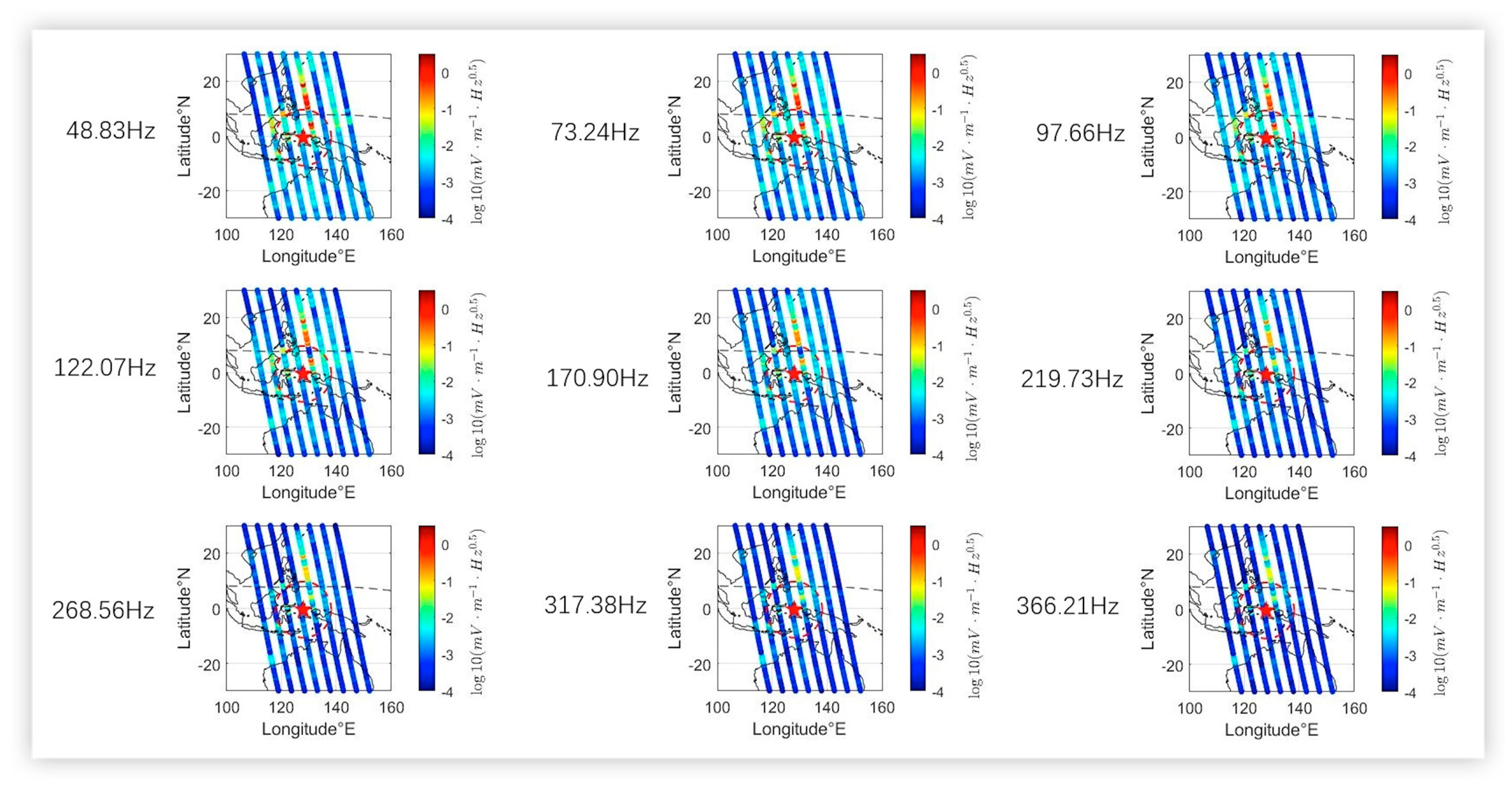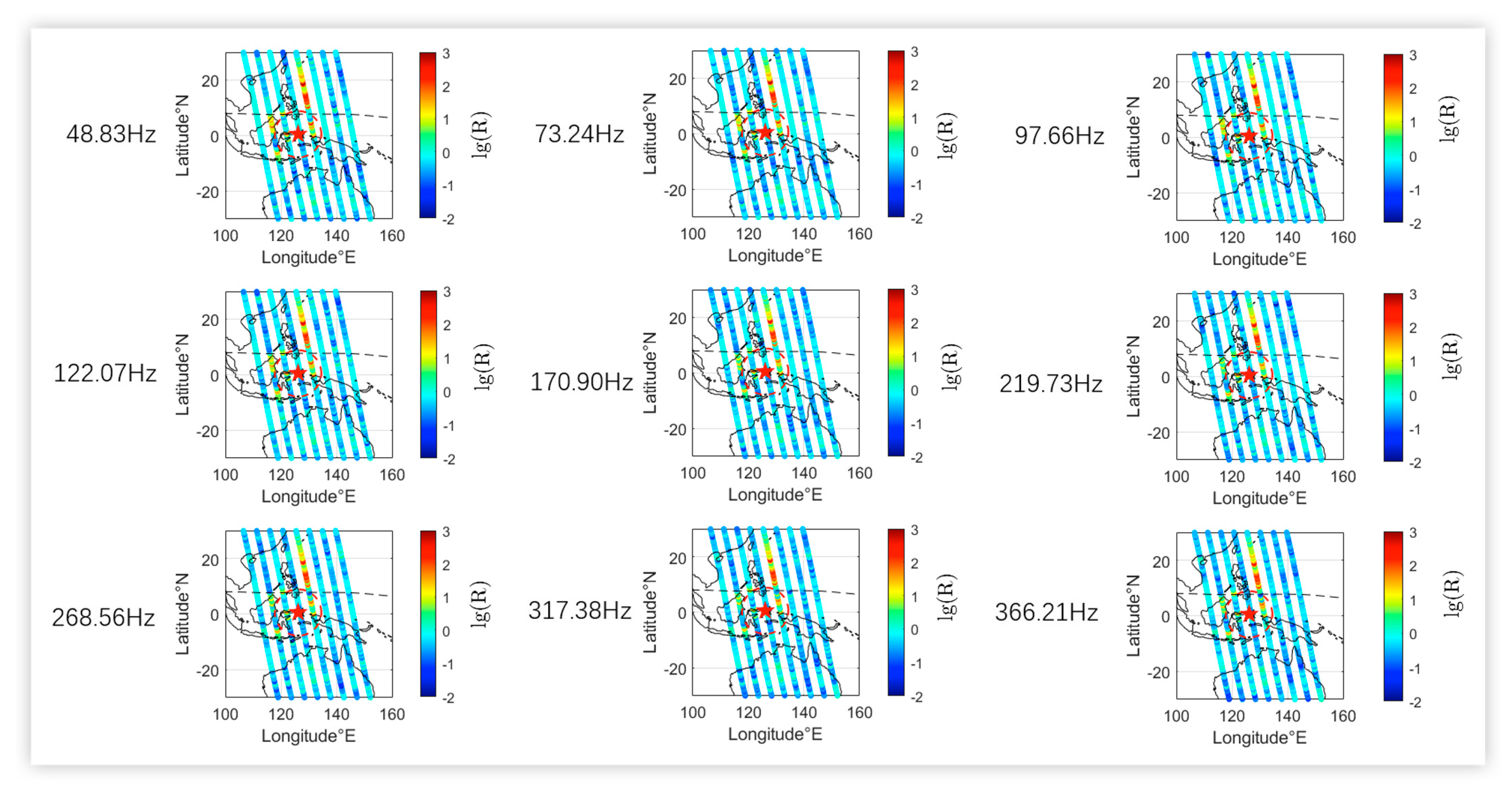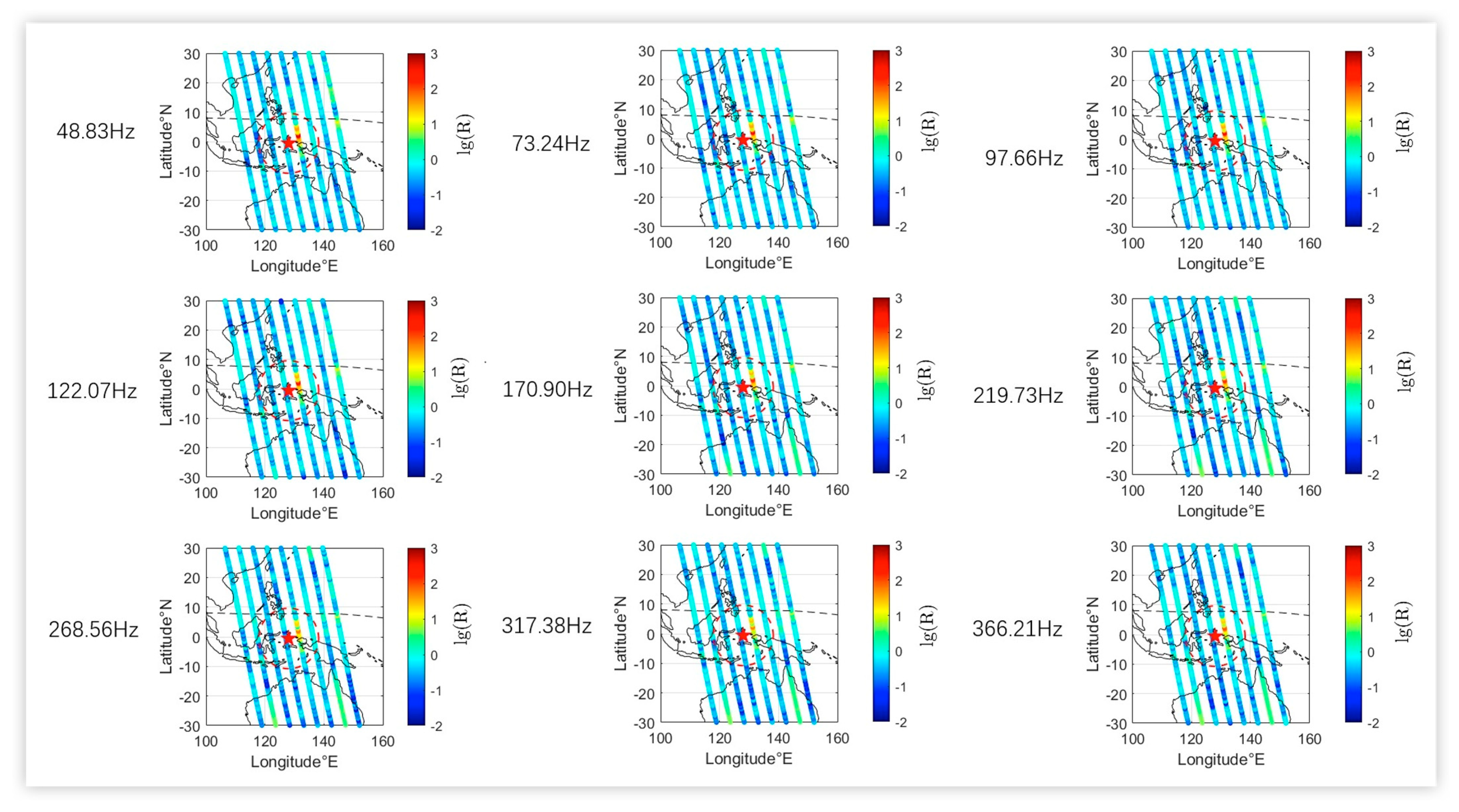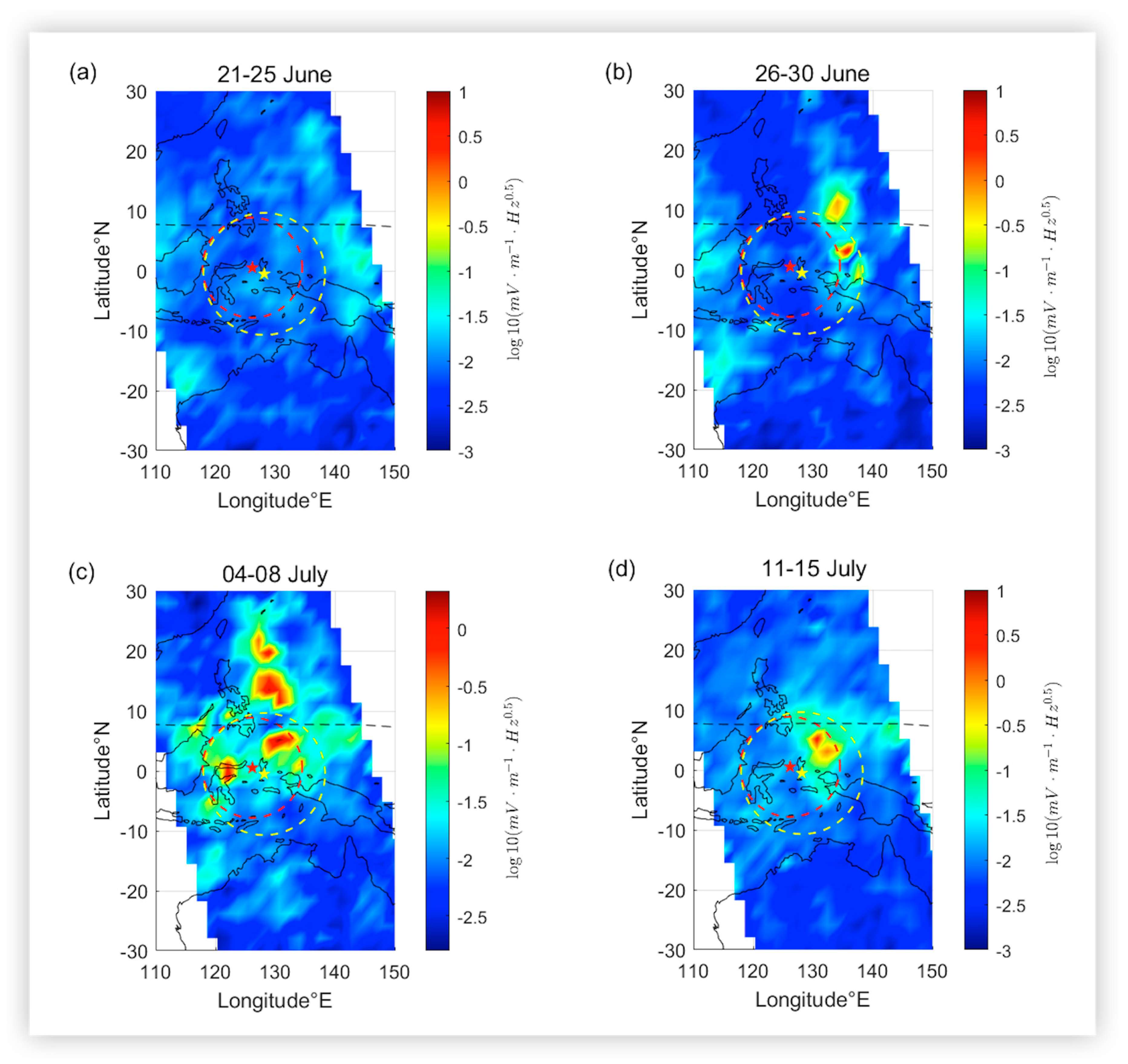Possible ELF/VLF Electric Field Disturbances Detected by Satellite CSES before Major Earthquakes
Abstract
:1. Introduction
2. Data Acquisition and Pre-Processing
2.1. The EFD Data
2.2. The Earthquake Information
2.3. Data Pre-Processing
- (1)
- Select the nighttime orbits that passing over the epicenters, namely the ascending orbits. Due to possible weak ionospheric disturbances caused by earthquake may be influenced by the solar radiation environment, the nighttime data were analyzed in this paper.
- (2)
- Considering the potential impact of solar and geomagnetic activities, a stringent condition (, and ) was set for selecting quiet period. The perturbation of the ionosphere caused by solar activity and interplanetary magnetic field is much greater than that caused by the movement of the earth’s crust. Therefore, only the orbital data during the quiet period were selected for analysis in this paper.
3. Methodology and Results
3.1. Analysis of Observed Values
3.2. Analysis of Relative Values
3.3. The Two-Dimensional Spatial Distribution
4. Discussion
5. Conclusions
- (1)
- The significant electric field anomalies in the ELF/VLF band (mainly from about 49 to 366 Hz) were detected near the epicenter, exactly in the northeast, of two strong low-latitude earthquakes by the electric field detector of CSES.
- (2)
- The electric field disturbances were mainly detected by satellite CSES over the epicenters at night, i.e., along the ascending orbits.
- (3)
- These abnormal enhancements will gradually diminish as the frequency increases.
- (4)
- The electric field anomalies started to appear in the northeast of the epicenters before the mainshocks and gradually moved closer to the sources after them. At the same time, a clear magnetically conjugated feature also gradually appeared before the first earthquake, but then faded away when approaching the next one.
Author Contributions
Funding
Institutional Review Board Statement
Informed Consent Statement
Data Availability Statement
Acknowledgments
Conflicts of Interest
References
- Gokhberg, M.B.; Morgounov, V.A.; Yoshino, T.; Tomizawa, I. Experimental Measurement of Electromagnetic Emissions Possibly Related to Earthquakes in Japan. J. Geophys. Res. 1982, 87, 7824. [Google Scholar] [CrossRef]
- Sorokin, V.; Chmyrev, V.; Yaschenko, A. Electrodynamic Model of the Lower Atmosphere and the Ionosphere Coupling. J. Atmos. Sol.-Terr. Phys. 2001, 63, 1681–1691. [Google Scholar] [CrossRef]
- Hayakawa, M. VLF/LF Radio Sounding of Ionospheric Perturbations Associated with Earthquakes. Sensors 2007, 7, 1141–1158. [Google Scholar] [CrossRef]
- Pulinets, S.; Ouzounov, D. Lithosphere-Atmosphere-Ionosphere Coupling (LAIC) Model—An Unified Concept for Earthquake Precursors Validation. J. Asian Earth Sci. 2011, 41, 371–382. [Google Scholar] [CrossRef]
- Huang, Q. Rethinking Earthquake-Related DC-ULF Electromagnetic Phenomena: Towards a Physics-Based Approach. Nat. Hazards Earth Syst. Sci. 2011, 11, 2941–2949. [Google Scholar] [CrossRef]
- Zhima, Z.; Shen, X.; Zhang, X.; Cao, J.; Huang, J.; Ouyang, X.; Jing, L.; Lu, B. Possible Ionospheric Electromagnetic Perturbations Induced by the Ms7.1 Yushu Earthquake. Earth Moon Planets 2012, 108, 231–241. [Google Scholar] [CrossRef]
- Zhang, X.; Shen, X.; Parrot, M.; Zeren, Z.; Ouyang, X.; Liu, J.; Qian, J.; Zhao, S.; Miao, Y. Phenomena of Electrostatic Perturbations before Strong Earthquakes (2005–2010) Observed on DEMETER. Nat. Hazards Earth Syst. Sci. 2012, 12, 75–83. [Google Scholar] [CrossRef]
- Zhang, X.; Fidani, C.; Huang, J.; Shen, X.; Zeren, Z.; Qian, J. Burst Increases of Precipitating Electrons Recorded by the DEMETER Satellite before Strong Earthquakes. Nat. Hazards Earth Syst. Sci. 2013, 13, 197–209. [Google Scholar] [CrossRef]
- Zhou, B.; Yang, Y.; Zhang, Y.; Gou, X.; Cheng, B. Magnetic Field Data Processing Methods of the China Seismo-Electromagnetic Satellite. Earth Planet. Phys. 2018, 2, 455–461. [Google Scholar] [CrossRef]
- Zhima, Z.; Hu, Y.; Piersanti, M.; Shen, X.; Guo, F. The Seismic Electromagnetic Emissions During the 2010 Mw 7.8 Northern Sumatra Earthquake Revealed by DEMETER Satellite. Front. Earth Sci. 2020, 8, 572393. [Google Scholar] [CrossRef]
- Wang, Q.; Huang, J.; Zhao, S.; Zhima, Z.; Yan, R.; Lin, J.; Yang, Y.; Chu, W.; Zhang, Z.; Lu, H. The Electromagnetic Anomalies Recorded by CSES during Yangbi and Madoi Earthquakes Occurred in Late May 2021 in West China—ScienceDirect. Nat. Hazards Res. 2022, 2, 1–10. [Google Scholar] [CrossRef]
- Li, Z.; Yang, B.; Huang, J.; Yin, H.; Yang, X.; Liu, H.; Zhang, F.; Lu, H. Analysis of Pre-Earthquake Space Electric Field Disturbance Observed by CSES. Atmosphere 2022, 13, 934. [Google Scholar] [CrossRef]
- Cohen, M.B.; Inan, U.S. Terrestrial VLF Transmitter Injection into the Magnetosphere. J. Geophys. Res.-Space Phys. 2012, 117, A08310. [Google Scholar] [CrossRef]
- Zhao, S.; Zhou, C.; Shen, X.; Zhima, Z. Investigation of VLF Transmitter Signals in the Ionosphere by ZH-1 Observations and Full-Wave Simulation. J. Geophys. Res.-Space Phys. 2019, 124, 4697–4709. [Google Scholar] [CrossRef]
- Lagoutte, D.; Brochot, J.; de Carvalho, D.; Elie, F.; Harivelo, F.; Hobara, Y.; Madrias, L.; Parrot, M.; Pincon, J.; Berthelier, J.; et al. The DEMETER Science Mission Centre. Planet. Space Sci. 2006, 54, 428–440. [Google Scholar] [CrossRef]
- Parrot, M.; Benoist, D.; Berthelier, J.; Blecki, J.; Chapuis, Y.; Colin, F.; Elie, F.; Fergeau, P.; Lagoutte, D.; Lefeuvre, F.; et al. The Magnetic Field Experiment IMSC and Its Data Processing Onboard DEMETER: Scientific Objectives, Description and First Results. Planet. Space Sci. 2006, 54, 441–455. [Google Scholar] [CrossRef]
- Bertello, I.; Piersanti, M.; Candidi, M.; Diego, P.; Ubertini, P. Electromagnetic Field Observations by the DEMETER Satellite in Connection with the 2009 L’Aquila Earthquake. Ann. Geophys. 2018, 36, 1483–1493. [Google Scholar] [CrossRef]
- Bhattacharya, S.; Sarkar, S.; Gwal, A.K.; Parrot, M. Satellite and Ground-Based ULF/ELF Emissions Observed before Gujarat Earthquake in March 2006. Curr. Sci. 2007, 93, 41–46. [Google Scholar]
- Walker, S.N.; Kadirkamanathan, V.; Pokhotelov, O.A. Changes in the Ultra-Low Frequency Wave Field during the Precursor Phase to the Sichuan Earthquake: DEMETER Observations. Ann. Geophys. 2013, 31, 1597–1603. [Google Scholar] [CrossRef]
- Nemec, F.; Santolik, O.; Parrot, M. Decrease of Intensity of ELF/VLF Waves Observed in the Upper Ionosphere Close to Earthquakes: A Statistical Study. J. Geophys. Res.-Space Phys. 2009, 114, A04303. [Google Scholar] [CrossRef]
- Shen, X.H.; Zong, Q.G.; Zhang, X.M. Introduction to Special Section on the China Seismo-Electromagnetic Satellite and Initial Results. Earth Planet. Phys. 2018, 2, 439–443. [Google Scholar] [CrossRef]
- Wen, Y.Z.; Tao, D.; Wang, G.X.; Zong, J.Y.; Cao, J.B.; Battiston, R.; Zeren, Z.M.; Shen, X.H. Ionospheric TEC and Plasma Anomalies Possibly Associated with the 14 July 2019 M_(w) 7.2 Indonesia Laiwui Earthquake, from Analysis of GPS and CSES Data. Earth Planet. Phys. 2022, 6, 16. [Google Scholar] [CrossRef]
- Zhao, S.; Shen, X.; Liao, L.; Zeren, Z. A Lithosphere-Atmosphere-Ionosphere Coupling Model for ELF Electromagnetic Waves Radiated from Seismic Sources and Its Possibility Observed by the CSES. Sci. China-Technol. Sci. 2021, 64, 2551–2559. [Google Scholar] [CrossRef]
- Huang, J.P.; Lei, J.G.; Li, S.X.; Zeren, Z.M.; Li, C.; Zhu, X.H.; Yu, W.H. The Electric Field Detector (EFD) Onboard the ZH-1 Satellite and Firstobservational Results. Earth Planet. Phys. 2018, 2, 10. [Google Scholar] [CrossRef]
- Dobrovolsky, I.P.; Zubkov, S.I.; Miachkin, V.I. Estimation of the Size of Earthquake Preparation Zones. Pure Appl. Geophys. 1979, 117, 1025–1044. [Google Scholar] [CrossRef]
- Pulinets, S. Ionospheric Precursors of Earthquakes; Recent Advances in Theory and Practical Applications. TAO Terr. Atmos. Ocean. Sci. 2004, 15, 413. [Google Scholar] [CrossRef]
- Yan Rui; Wang Lanwei; Hu Zhe; Liu Dapeng; Zhang Xingguo; Zhang Yu Ionospheric Disturbances before and after Strong Earthquakes Based on DEMETER Data. Acta Seismol. Sin. 2013, 35, 498–511.
- Serebryakova, O.N.; Bilichenko, S.V.; Chmyrev, V.M.; Parrot, M.; Rauch, J.L.; Lefeuvre, F.; Pokhotelov, O.A. Electromagnetic ELF Radiation from Earthquake Regions as Observed by Low-altitude Satellites. Geophys. Res. Lett. 2013, 19, 91–94. [Google Scholar] [CrossRef]
- Lehtinen, N.G.; Inan, U.S. Full-Wave Modeling of Transionospheric Propagation of VLF Waves. Geophys. Res. Lett. 2009, 36, L03104. [Google Scholar] [CrossRef]
- Nitsan; Uzi Electromagnetic Emission Accompanying Fracture of Quartz-Bearing Rocks. Geophys. Res. Lett. 1977, 4, 333–336. [CrossRef]
- Ikeya, M.; Takaki, S.; Matsumoto, H.; Tani, A.; Komatsu, T. Pulsed Charge Model of Fault Behavior Producing Seismic Electric Signals (SES). J. Circuits Syst. Comput. 1997, 7, 153–164. [Google Scholar] [CrossRef]
- Huang, Q. One Possible Generation Mechanism of Co-Seismic Electric Signals. Proc. Jpn. Acad. Ser. B-Phys. Biol. Sci. 2002, 78, 173–178. [Google Scholar] [CrossRef] [Green Version]
- Mizutani, H.; Ishido, T.; Yokokura, T.; Ohnishi, S. Electrokinetic Phenomena Associated with Earthquakes. Geophys. Res. Lett. 1976, 3, 365–368. [Google Scholar] [CrossRef]
- Johnston, M. Review of Electric and Magnetic Fields Accompanying Seismic and Volcanic Activity. Surv. Geophys. 1997, 18, 441–476. [Google Scholar] [CrossRef]
- Aleksandrin, S.Y.; Galper, A.M.; Grishantzeva, L.A.; Koldashov, S.V.; Voronov, S.A. High-Energy Charged Particle Bursts in the near-Earth Space as Earthquake Precursors. Ann. Geophys. 2003, 21, 597–602. [Google Scholar] [CrossRef]
- Sgrigna, V.; Carota, L.; Conti, L.; Corsi, M.; Galper, A.M.; Koldashov, S.V.; Murashov, A.M.; Picozza, P.; Scrimaglio, R.; Stagni, L. Correlations between Earthquakes and Anomalous Particle Bursts from SAMPEX/PET Satellite Observations. J. Atmos. Sol.-Terr. Phys. 2005, 67, 1448–1462. [Google Scholar] [CrossRef]
- Liu, J.Y.; Chen, Y.I.; Chen, C.H.; Liu, C.Y.; Chen, C.Y.; Nishihashi, M.; Li, J.Z.; Xia, Y.Q.; Oyama, K.I.; Hattori, K. Seismoionospheric GPS Total Electron Content Anomalies Observed before the 12 May 2008 Mw7.9 Wenchuan Earthquake. J. Geophys. Res. Space Phys. 2009, 114, A04320. [Google Scholar] [CrossRef]
- Gulyaeva, T.L.; Arikan, F.; Stanislawska, I.; Poustovalova, L.V. Symmetry and Asymmetry of Ionospheric Weather at Magnetic Conjugate Points for Two Midlatitude Observatories. Adv. Space Res. 2013, 52, 1837–1844. [Google Scholar] [CrossRef]
- Tao, D.; Wang, G.; Zong, J.; Wen, Y.; Cao, J.; Battiston, R.; Zeren, Z. Are the Significant Ionospheric Anomalies Associated with the 2007 Great Deep-Focus Undersea Jakarta-Java Earthquake? Remote Sens. 2022, 14, 2211. [Google Scholar] [CrossRef]






| No. | Time | Mag. | Depth | Lat. | Lon. |
|---|---|---|---|---|---|
| 1 | 7 July 2019 15:08:40 UT | Mw6.9 | 35.0 km | 0.51° N | 126.19° E |
| 2 | 14 July 2019 09:10:51 UT | Mw7.2 | 19.0 km | 0.59° S | 128.03° E |
Publisher’s Note: MDPI stays neutral with regard to jurisdictional claims in published maps and institutional affiliations. |
© 2022 by the authors. Licensee MDPI, Basel, Switzerland. This article is an open access article distributed under the terms and conditions of the Creative Commons Attribution (CC BY) license (https://creativecommons.org/licenses/by/4.0/).
Share and Cite
Zong, J.; Tao, D.; Shen, X. Possible ELF/VLF Electric Field Disturbances Detected by Satellite CSES before Major Earthquakes. Atmosphere 2022, 13, 1394. https://doi.org/10.3390/atmos13091394
Zong J, Tao D, Shen X. Possible ELF/VLF Electric Field Disturbances Detected by Satellite CSES before Major Earthquakes. Atmosphere. 2022; 13(9):1394. https://doi.org/10.3390/atmos13091394
Chicago/Turabian StyleZong, Jiayi, Dan Tao, and Xuhui Shen. 2022. "Possible ELF/VLF Electric Field Disturbances Detected by Satellite CSES before Major Earthquakes" Atmosphere 13, no. 9: 1394. https://doi.org/10.3390/atmos13091394
APA StyleZong, J., Tao, D., & Shen, X. (2022). Possible ELF/VLF Electric Field Disturbances Detected by Satellite CSES before Major Earthquakes. Atmosphere, 13(9), 1394. https://doi.org/10.3390/atmos13091394







